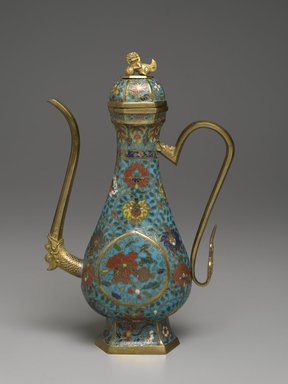
Medium: Cloisonné enamel on copper alloy
Geograhical Locations:
Dates:late 16th–early 17th century
Dimensions: 13 1/2 x 3 1/4 x 3 1/4 in. (34.3 x 8.3 x 8.3 cm)
Collections:
Accession Number: 09.574a-b
Image: 09.574a-b_front_PS2.jpg,
Catalogue Description: A ewer from the late Ming period, without a reign mark. Shaped like a Persian golabash, the ewer with a slightly spreading hexagonal foot and a pear-shaped body flattened on two opposite sides and tapering to a tall slender neck with a cup-shaped hexagonal mouth. Springing from the body to the neck is a tall, elegantly curved handle, the upper end of which is decorated with a dragon's head in relief, and from the opposite side of the body rises a tall S-shaped spout, the lower end of which is also decorated with a dragon's head. The hexagonal cover has high rounded sides and a flat top surmounted by a lion dog playing with a ball. Copper, gilded on the rims, the handle, the lion dog and the spout, and decorated on the outside with cloisonné enamels. On the foot and the cover are flower scrolls and on the neck are more flower scrolls and inverted stiff leaves. On either flattened side of the body are large round plaques, pointed at the top, containing a flower design, on a ground of lotus scrolls. The colors are red, yellow, deep blue, brown, two shades of green, and white on turquoise blue ground. The cloisons alone form the stems in the design. The handle and spout together with the bronze guardian lion finial may be later additions.